Types of Tree Seed Pods – Identification Guide With Pictures

Identifying seed pods is a great way to recognize different species of trees. One of the benefits of using seed pods for tree identification is that you usually find seed enclosures on the ground. This can make it easier to identify a tree species than using the leaf shape. Tree seed pods can be winged, ball-shaped, coniferous cones, papery enclosures, or long slender pods like bean pods.
Of course, it’s not always possible to use a tree seed pod identification guide to identify trees. Seed pods may only fall to the ground after flowering. And the seed pods on some species of trees persist on the tree throughout winter. However, looking at the shape, size, and color of the seed pod can often help identify the tree.
The term “seed pod” typically refers to the seed-bearing structure of plants in the legume family (Fabaceae). These pods are usually long and slender, containing several round pea-like seeds in a row. However, tree seed pods can also refer to any type of casing that contains seeds from a tree or large shrub.
This article is an identification guide for tree seed pods. In it, you’ll discover how to identify seed pods from trees like maples, elms, ash, silver birch, beech, chestnut, and several types of conifers. Descriptions and pictures of seed pods and other identifying features of trees will help you distinguish species of trees in the landscape.
Tree Seed Pod Identification
The two primary ways to identify seed pods are by looking at their shape and size. However, tree seed pod identification is also possible by the feel of the pod — is it smooth, fuzzy, or spiky? Additionally, some types of seed pods fall relatively early in the season, whereas others stay on the tree throughout winter.
Tree seed pod identification — shape: First, look at the seed pod’s shape. Most trees in the legume family have long, slender, curved pods, like those you’d find on pea and bean plants.
However, many deciduous trees, like ash, maple, and elm, have flattened, papery seed casings called samaras. However, most coniferous trees have seed-containing cones. But chestnut, hickory, and beech trees have rounded pods, sometimes with spiky exteriors.
Tree seed pod identification — size: The seed pod’s size is another identifying feature to help recognize the tree species. There is great variation in the length of some tree seed pods in the legume family. For example, flat redbud tree seed pods measure 3” (7.5 cm) long. However, mimosa tree pods grow 4” to 8” (10 – 20 cm) long, and locust tree seed pods measure 6” to 18” (15 – 45 cm).
The seed pods of trees are called fruits, although we never think of papery winged seeds or long curled pods as fruits. Additionally, sometimes tree seeds are also referred to as nuts.
Types of Tree Seed Pods (With Pictures) – Identification Guide
All trees produce seeds to reproduce. However, many tree seeds develop in pods or other protective structures. For example, some seed pods are like leathery balls, whereas others are woody cones. Then there are papery winged seeds that fall to the ground, spinning like a helicopter’s blades. How can you identify the many types of tree seed pods? Please read on to find out.
Maple Tree Seed Pods
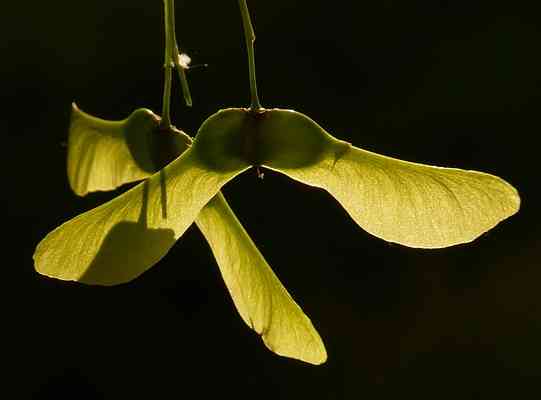
Maple tree seed pods are called samaras and contain a pair of seeds attached to a “wing” that carries the seed a long distance when it’s windy
Maple tree seed pods look like a pair of wing-shaped papery structures joined in the middle. Each winged section is called a samara. These seed pods are also named helicopter seeds because when they drop from the tree, they have a characteristic spinning motion. This feature gives the seeds names like whirlers, helicopters, or whirligigs.
Maple tree seed pods grow 1.18” to 2” (3 – 5 cm) long. Seeds from maples are the only samara with true helicopter-like action.
The wing-like structure helps the seeds to disperse in the wind, far away from the tree. Other identification features of maple trees include their leaves with usually three or five pointed lobes, reddish-brown bark or gray-brown bark. Many species of maple trees (Acer spp.) grow up to 150 ft. (45 m) tall.
Elm Tree Seed Pods
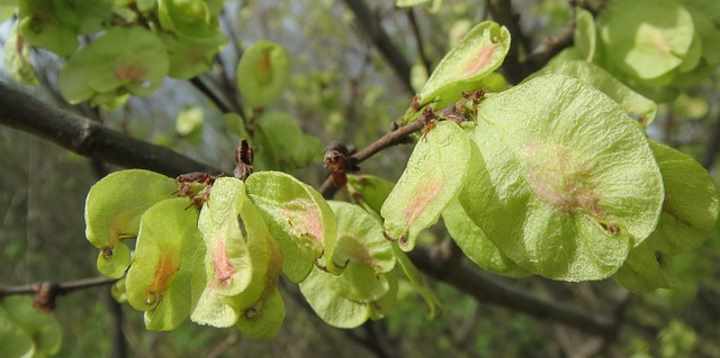
Elm tree seed pods are small and round and are protected in an oval papery casing
Elm trees produce seed pods encased in flat, papery, oval pods. Each elm tree seed pod contains a single seed, and the light green disc-like pods grow in large clusters on the tree. The papery seeds typically disperse from the tree in spring after flowering. Elm tree seed pods measure 0.5” (1.22 cm) across.
Apart from the round seed casing, elm trees can be identified by their deep green, oval, pointed leaves with serrated margins. In addition, elm trees have dark grayish-brown bark that is heavily furrowed and scaly. They also have small clusters of red or green flowers. Elm trees (Ulmus spp.) grow up to 100 ft. (30 m) tall.
Ash Tree Seed Pods
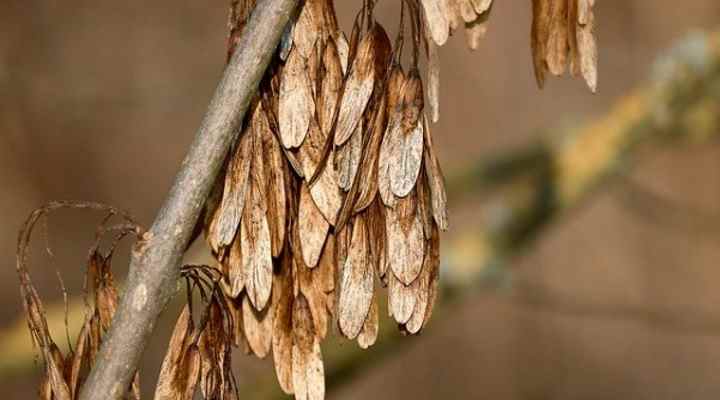
Ash tree seed pods are a type of winged seed that grow in clusters on the stems
Ash tree seed pods are large oval paddle-shaped papery pods growing in large clusters. The brown winged seeds look like a bunch of dried leaves hanging from branches. Also called keys, the samaras persist on the tree until late fall or early winter. The oar-shaped seed pods measure 2” (5 cm) long.
Another distinguishing feature of ash trees (Fraxinus spp.) is their pinnately compound leaves. Each leaf comprises five pairs of pointed leaflets with a terminal leaflet at the end of the petiole. The leaves measure 8” to 12” (20 – 30 cm) in length. Ash trees typically grow 60 to 80 ft. (18 – 24 m) tall.
Learn more about white ash trees and the identifying features of green ash trees.
Beech Tree Seed Pods

The beech tree fruit (beechnut) on top left is encased in spiky seed pods called cupules
Beech tree seed pods are identified as brown, spiny burs that have a hard shell and are called cupules. Each brown seed pod contains two to four seeds. An unusual feature of beech nuts is their angular shape with three sides. Beech tree seeds measure 0.5” to 1” (1.12 – 2.5 cm) long, and the spiky burs are slightly larger.
Beech trees are deciduous trees belonging to the genus Fagus. Apart from the brown spiky seed pods, identification features of beech trees include large, glossy green leaves forming a rounded, spreading crown. Additionally, beech trees have smooth, light-gray bark. Beech trees grow 60 to 80 ft. (18 – 24 m) tall.
Silver Birch Tree Seed Pods
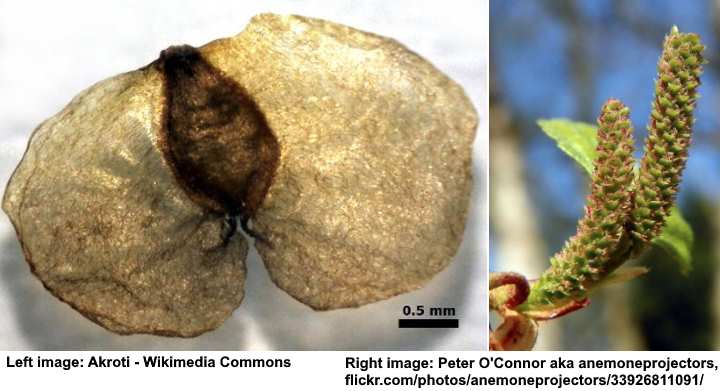
The silver birch (Betula pendula) seed (left) has a papery casing and develops in the catkins on female trees (right)
Silver birch seed pods are tiny, winged seeds that grow in clusters resembling long flower spikes called catkins. Each minuscule seed has a translucent papery casing that opens like two wings. The seeds develop in catkins on the female trees. A single silver birch tree can produce thousands of seeds every year.
Pictures of silver birch seeds look like small flies with a body (seed), two antennae-like protrusions, and a pair of wings. The seeds only measure 0.11” to 0.15” (3 – 4 mm) across. Other identifying features of the silver birch (Betula pendula) are its silvery white bark and triangular leaves with jagged edges growing on weeping branches.
Horse Chestnut Tree Seed Pods
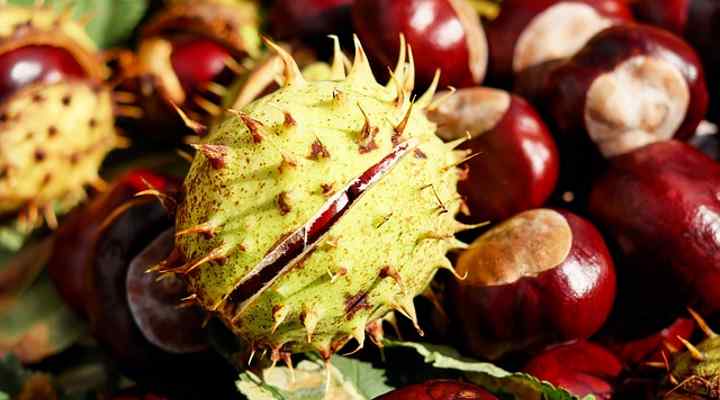
The reddish brown toxic horse chestnuts are encased in a spiky green rounded seed pod
Horse chestnut seed pods are spiky green balls formed by a soft, thick husk. The spongy casing opens to reveal a mahogany brown seed with a recognizable grayish patch. Typically, each horse chestnut seed pod has one or two fruits (seeds). The rounded pods measure 1” to 2” (2.5 – 5 cm) in diameter.
Horse chestnut trees (Aesculus hippocastanum) grow 50 to 70 ft. (15 – 21 m) tall. The large deciduous trees have large conical, upward point clusters of pinkish white flowers, large palmately compound leaves, slightly fissured grayish bark, and a distinctive pyramidal shape.
Buckeye trees, that are related to the horse chestnut trees, also produce seed pods similar to horse chestnut trees. But, unlike chestnut trees (Castanea spp.), horse chestnut seeds and buckeye seeds are toxic and inedible.
Chestnut Tree Seed Pods

The edible chestnut is formed in a spiny yellowish-brown seed pod that splits open to reveal shiny brown nuts
Chestnut tree seed pods are large, fuzzy, ball-like pods containing several large edible seeds or fruits. The spiky pods (called cupules) have sharp spines, and each pod contains several brown-colored seeds. An identifying feature of sweet, edible chestnut seeds is that they have a flat side and a small tuft.
Chestnut trees are identified by their lance-shaped, coarsely-toothed linear leaves measuring 6” to 10” (15 – 25 cm). Additionally, chestnut flowers are long, finger-like flower clusters in a creamy-white color. These dangling catkins measure 4” to 8” (10 – 20 cm) long. The fast-growing trees reach impressive heights of 60 to 100 ft. (18 – 30 m).
Redbud Tree Seed Pods
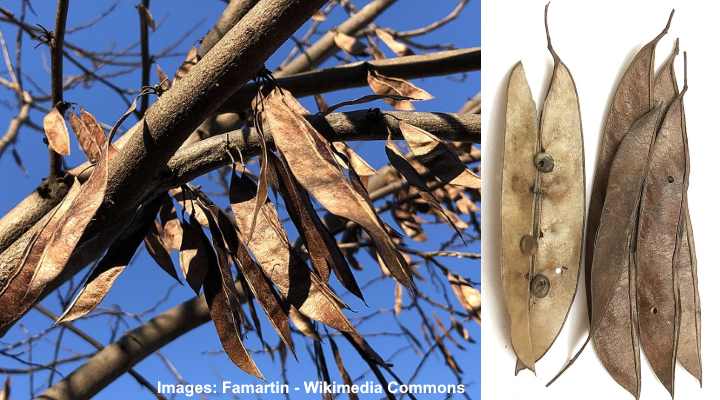
Redbud seed pods are long and flat and contain small pea-like seeds
Redbud tree seed pods are large, flattened bean-like pods dangling in large clusters. The narrow, pointed seed pods are green before turning dark maroon or purple and then brown as they dry on the tree. Each pod measures 3” (7.5 cm) long and contains many small pea-like seeds.
Western and eastern redbud trees (Cercis spp.) are deciduous trees growing 25 ft. (7.6 m) tall. Their bright magenta buds appear in spring before opening into showy, fragrant, vibrant pink or reddish-pink flowers. Redbud leaves are heart-shaped, and the green foliage turns yellow in the fall.
Sycamore Tree Seed Pods
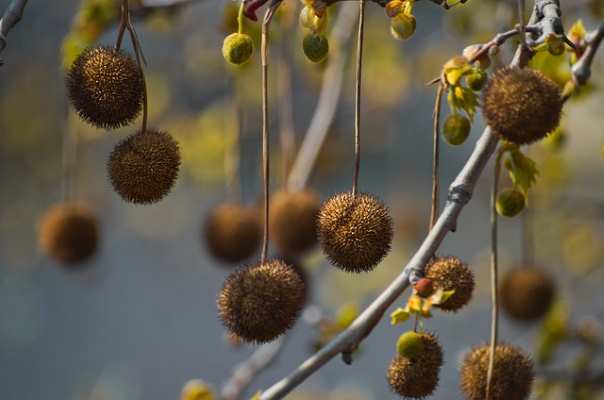
Sycamore trees produce spiky round seed pods that dangle on long petioles
Sycamore tree seed pods are spiky round balls that emerge green and turn brown. The small seed balls dangling on long petioles persist through winter before dropping to the ground in spring. Each jaggy seed pod contains many fluffy winged seeds that easily disperse when the sycamore seed pods break open.
The spiky seed balls measure 1” (2.5 cm) in diameter.
Sycamore trees (Platanus spp.) grow 100 to 130 ft. (30 – 40 m) tall. Apart from the brownish spiked seed pods, other identifying features are their maple-like leaves with deep, pointed lobes, smooth, thin colorful flaky bark that looks like camouflage, and insignificant greenish flowers.
Pine Tree Seed Pods (Cones)
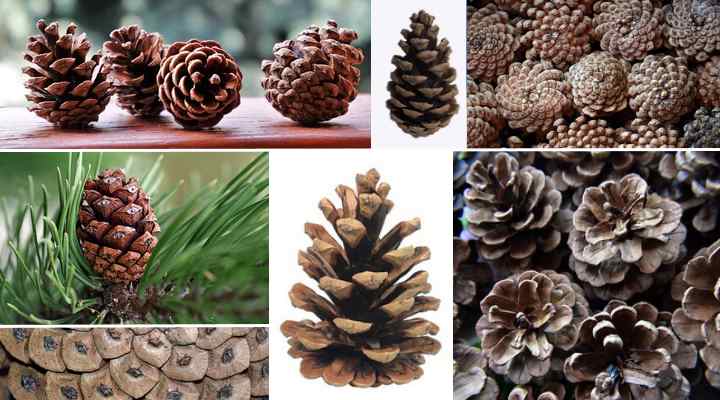
Pine cones come in various shapes and sizes
Pine tree seed pods are conical structures consisting of woody scales. Pine cones are typically tan or brown and can be egg-shaped or have a slender and conical appearance. Each woody scale encloses a tiny seed that disperses when the cones open. Depending on the species, pine tree cones can range in size from 0.78” to 23” (2 – 60 cm).
Pine cone seed pods can help distinguish pine trees from fir trees. This is because the brown, woody cone-shaped seed pods typically grow downward rather than upward. Other identifying features of pine trees (Pinus spp.) are their evergreen needle-like leaves growing in bunches of two to five and arranged spirally on branches.
Spruce Tree Seed Pods (Cones)
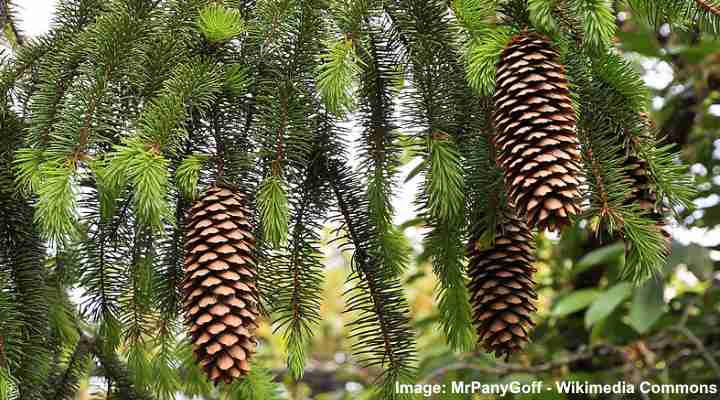
Spruce seed pods (cones) are slender and not as hard as pine cones
Spruce tree seed pods consist of thin, flexible scales attached to a central stalk creating a conical cone. The slender, cone-like seed pods can emerge green, red, or purple before maturing to brown. Although compared to pine cones, they look similar, spruce cones are not as hard or ridged.
The cone-shaped spruce tree seed pods grow between 1” and 6” (2.5 – 15 cm) depending on the species of conifer (Picea spp.). You can also identify spruce trees by their short, four-sided needles that are individually attached to branches. Unlike fir tree needles, you can roll spruce needles between your fingers.
Fir Tree Seed Pods (Cones)

The colorful fir tree seed pods (cones) usually grow upwards
Fir tree seed pods are cylindrical cones that grow upward on woody branches. Compared to other evergreen conifers, fir tree seed cones are the most colorful. Some are deep purple, pale blue, or reddish-brown color. Fir tree cones can grow up to 10” (25 cm) and look like candles on a tree.
Other identifying features of fir trees (Abies) are their soft, feathery flat needles and smooth bark.
Mimosa Tree Seed Pods

Mimosa tree seed pods are flat and bean-like and contain round seeds
Mimosa tree seed pods are identified as papery bean-like pods that emerge green and turn brown. Each flattened seed pod contains five to ten round seeds. The flat pods grow profusely on trees, dangling from bare branches in the fall. The tree seed pods measure 4” to 8” (1.2 – 2.4 cm) long and 1” (2.5 cm) wide.
Mimosa trees (Albizia Julibrissin) are also identified by their smooth, light gray bark, fern-like pinnately compound leaves, and pink puffball flowers.
Palo Verde Tree Seed Pods
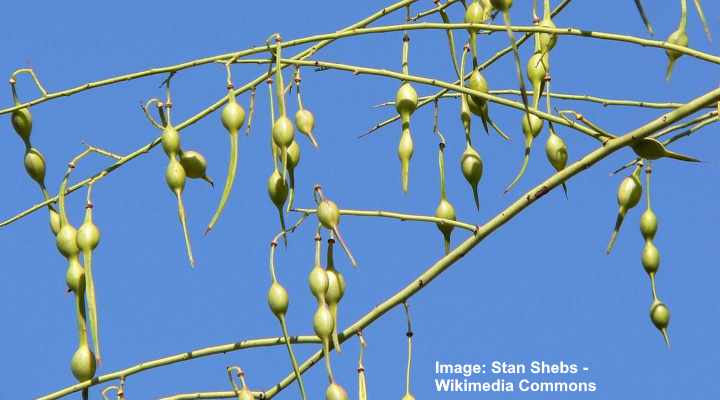
Palo verde seed pods look like beaded chains dangling from the branches
Palo verde tree seed pods are easily identifiable because they look like green, red, or brown beaded chains hanging from branches. The leathery seed pods contain edible oval seeds which are black or brown. The unusual leguminous (bean-like) seed pods measure 2” to 3” (5 – 7.5 cm) long.
Palo verde trees (Parkinsonia spp.) have bright yellow flowers and thorny branches, covered in pinnate leaves with pairs of tiny leaflets growing in pairs oppositely on thorny stems measuring 6” to 9” (15 – 23 cm) long.
Royal Poinciana Tree Seed Pods
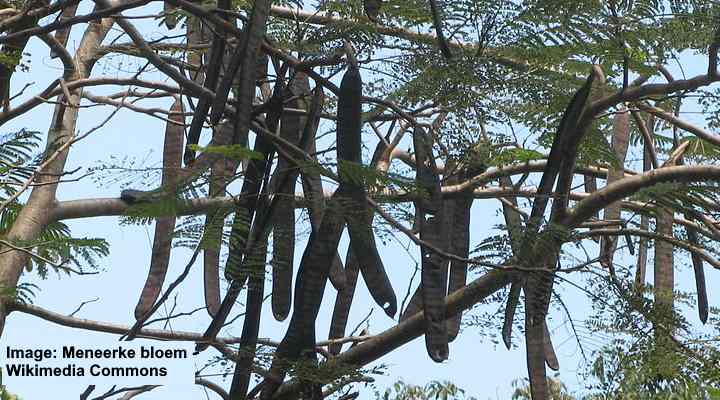
Royal poinciana seed pods are long and flat and have a dark brown color
Royal poinciana tree seed pods are huge leguminous seed pods growing between 12” and 24” (30 – 60 cm) long. The dark brown, flattened seed-containing pods look like leather straps hanging from trees. These large seed pods emerge in the fall and persist on the tree through winter until spring.
Other identifying features of royal poinciana trees (Delonix regia) are their bi-pinnate feathery leaves, vibrantly colored red flowers, and large, spreading rounded crown.
Locust Tree Seed Pods
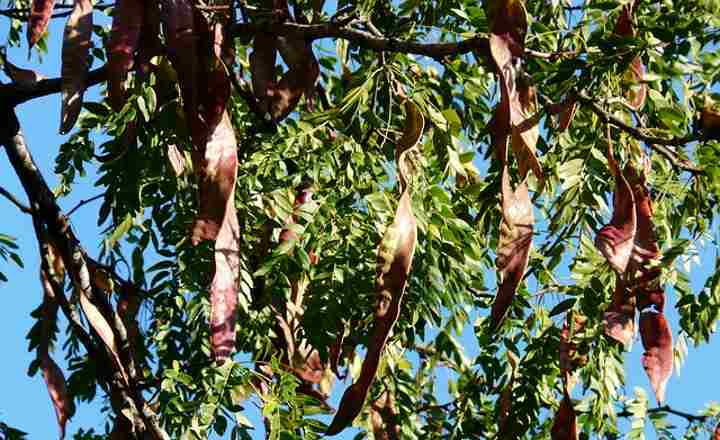
The brown locust tree seed pods are long, flat and spirally twisted
Locust tree seed pods are large, flattened, dark brown pods that are distinctively spirally twisted. Each of these contorted or hooked seed pods contains several large oval seeds. Locust seed pods grow 4” to 8” (10 – 20 cm) long and dangle from thorny branches from fall until the following spring.
Locust trees (Robinia spp.) grow 66 to 100 ft. (20 – 30 m) tall. They are identified by their large pinnate leaves, thorn-covered trunks, and dangling clusters of white flowers.
Kentucky Coffee Tree Seed Pods
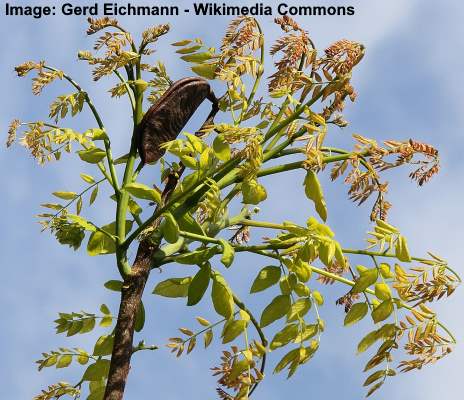
Kentucky coffee trees have dark brown and flat seed pods
Kentucky coffee tree seed pods are flattened, thick, leathery pods that measure 5” to 10” (12 – 25 cm) long and up to 2” (5 cm) wide. The large seed pods contain dark-brown or olive-green round seeds, with three to nine seeds per pod. Although the seeds are toxic, you can roast them and brew a coffee-like drink.
Other identifying features of Kentucky coffee trees (Gymnocladus dioicus) are their rough, scaly bark, large, pinnately compound leaves, and small white, star-shaped flowers.
Catalpa Tree Seed Pods
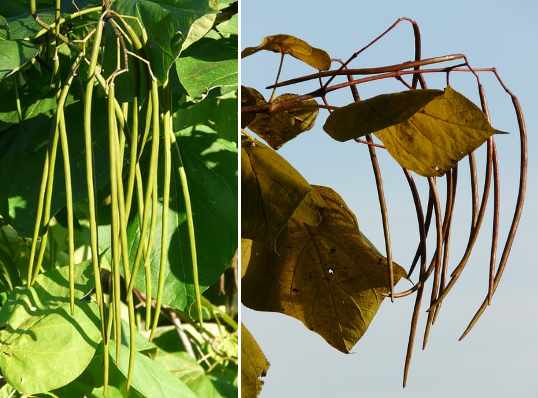
Immature green catalpa seed pods (left) and mature brown seed pods (right)
Catalpa tree seed pods are easily recognizable pods due to their slender, cylindrical shape and long length — measuring between 12” and 24” (30 – 60 cm). These long cigar-like seed pods grow in dangling clusters that are green and mature to dark brown. Winged seeds disperse when the pods split open.
Other names for catalpa trees (Catalpa spp.) are the bean tree, Indian cigar tree, and smoking bean tree. The catalpa tree also has showy white flowers, smooth gray bark, and heart-shaped green leaves.
Jacaranda Tree Seed Pods

The rounded brown jacaranda tree seed pods contain many winged seeds
Jacaranda tree seed pods are round, brown, woody pods with numerous winged seeds. The brownish seed pods grow in clusters on trees and have a twisted appearance. The pods measure 3” (7.5 cm) across and are noticeable on jacaranda trees in late summer. Resembling a small scallop, the pods open to disperse their seeds.
Jacaranda trees (Jacaranda mimosifolia) are famous for their stunning floral displays of blue or bluish-purple trumpet-shaped flowers, attractive bi-pinnate compound leaves, and grayish-brown scaly bark.
Acacia Tree Seed Pods
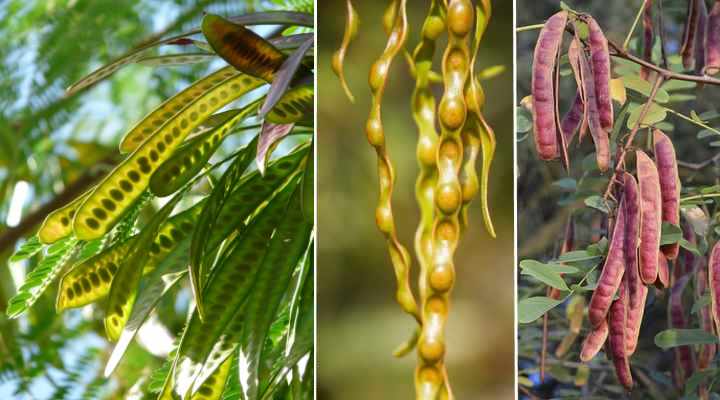
Acacia seed pods have various shapes and colors depending on the species
Acacia tree seed pods are known for their long, slender seed-bearing pods that look like rosary beads or necklaces. However, some acacia species have flattened, broad seed pods that are banana-shaped. The distinctive furry seed pods are typically dark brown and grow up to 10” (26 cm) long. Each legume pod contains several pea-like seeds.
Acacia trees (Acacia spp.) are easy to identify due to their spectacular white or yellow puffball fuzzy flowers, fern-like leaves, and thorny branches.
Related articles:
- Trees With Long Seed Pods – Identification Guide
- Trees With Spiky Seeds Balls (With Pictures)
- Types of Hickory Nuts – Identification Guide
